
While some of the hype around AI seems to be slowing from its lofty peaks of 2023, many are finding the real-world practical applications for the technology. For those with ecommerce websites AI can significantly enhance the performance, efficiency, and user experience for visitors.
One of the obvious early benefits for users of the likes of ChatGPT was for its ability to generate content quickly. Inputting some bullet points and asking it to create product descriptions or SEO’d page titles prevented the horrible feeling of staring at a blank page waiting for inspiration.
That idea has now been built-in to the Shopify platform, where AI can be used to help write product descriptions from a basic prompt. For product images, Shopify have also introduced the ability to to transform backgrounds to showcase your product in multiple locations based on your prompt.
Popular SEO WordPress plugin YOAST has AI-powered suggestions for meta descriptions in the paid version of the add-on.
Artificial Intelligence can analyse the user data of people accessing your site helping you to find and retain customers. One of the more involved ways of using AI in ecom is to personalise a user’s shopping experience. Further than just a “welcome back” message or a generic “you may also like”, these tools analyse user behaviour based on past purchases and site browsing history to provided targeted and individually personalised product recommendations. BloomReach’s system allows for custom banners and targeted discounts moving away from site-wide one-size fits all marketing messages.

One element in the sudden rise of AI was the improvement of natural language processing, which is how computers understand humans. Using NLP, AI can interpret the shopper’s query allowing you to more accurately understand their intent and deliver the search results they’re looking for. AI can also enhance search accuracy by adding synonyms, filling in missing words or phrases, and automatically correcting spelling errors. E.g. a search for “sneakers” could be substituted for a search for “trainers”.
As with site personalisation, a user’s on-site behaviour and purchase history can be used to aid with future intent, so when they do use the search on your site you can present items they may be more inclined to want. Klevu’s site search utililses machine learning and natural language processing for advanced configuration options.
Customer Services & Support
Chatbots have been around for a number of years, with many people suffering frustrating customer service encounters with them. However, some of the more modern bots can be almost undetectable from real humans for straightforward enquiries. Intercom.com’s Fin AI agent provides a live help service and pulls in information from across your website to make sure consumers get accurate answers.
Pricing
It takes a lot of time and research to know what to price your products in an ever-changing market. There are AI tools that can analyse market dynamics and competitor pricing to help you find the right price for your products. This can be coupled with other elements such as consumer demand and inventory levels for real-time dynamic pricing.
AI is transforming e-commerce, offering tools that can improve customer experience, personalization, search functionality, and pricing strategies. Even if some tools don’t fit your needs now, staying updated on AI trends ensures you’re ready to adapt and stay competitive as the technology evolves. Monitoring these trends can help you spot new opportunities, streamline operations, and future-proof your business in an ever-changing market.
Black Friday is seen by many retailers as one of the biggest selling opportunities of the year. But is a Black Friday sale the right option for your business?
Since it was introduced to the UK by Amazon in 2010, Black Friday has become a much anticipated four-day long retail event, which sees retailers release big offers and discounts to mark the beginning of the Christmas shopping season. This year’s Black Friday falls on November 24th and is likely to be one of the largest ever, particularly for online sales.
But Black Friday is also associated with fuelling hyper-consumerism, irresponsible production and damaging smaller businesses who cannot compete with the discounts on offer from bigger retailers. The notoriety of the sales mean it is not uncommon to see false discounting, and even entire fake stores designed to catch the unsuspecting consumer.
Because of this, some big brands are choosing to opt out of Black Friday altogether, and 85% of independent retailers also boycott the event.
The brands doing Black Friday differently
For a number of years some socially and environmentally conscious brands have been boycotting Black Friday.
IKEA boycotted Black Friday sales last year, saying that they don’t do large sales because they strive to have the most affordable prices possible all year round. In the place of Black Friday, they are favouring their Green Friday initiative, which enables customers to get 50% off new items when returning an old item to the store through the Buyback & Resell scheme.
Patagonia, for example, does not participate in Black Friday in the usual way, instead committing to repairing clothes, buying used, and buying quality to improve sustainability and help tackle the climate crisis. For Black Friday 2011, the brand ran an ad in The New York Times highlighting overconsumption, and in 2016 donated 100% of Black Friday sales to grassroots organizations.
Skincare brand Deciem have opted to close down their website and store for 24 hours each Black Friday. Instead, they have a month-long sale as part of their ‘Slowvember’ campaign, to encourage consumers to take time to consider whether the product is necessary and the right product for them, instead of impulse buying, which can lead to waste.
Despite their hugely popular Boxing Day sale, Next has opted out of Black Friday since 2020. While they’ve never divulged the reason, the general thinking is that it is a push towards sustainability.
Boycotting Black Friday can actually help your business, communicating that you have confidence in the value of your product at full price and, in doing so, building trust with your customers.
However, Black Friday also has many positives: most importantly, sales are a valuable opportunity for consumers to purchase necessary items that are too expensive at full price.
Our advice is do what suits your business best. If you are going to participate in the nation-wide discount extravaganza, consider your offer and why you’re doing it, keeping your customer experience and business values in mind. Make sure you keep in touch with the wider team, including delivery companies, website hosting etc to make sure they’re geared up as well to support your promotion.
The online food and drink sector is a fast-changing and competitive market, so it is important to continuously review and revise your online marketing. At Infotex we support our clients with the best Search Engine Optimisation (SEO) and digital marketing practices to help their websites keep up with the market.
Read on to learn how we support our food and drink clients with digital marketing strategies, and for examples of clients’ food and drink websites.
Support comes in many forms, but on the digital marketing front there are three essential strategies we know are most effective for driving traffic to websites in the food and drink sector.

Through our SEO and digital marketing practices, we have been able to attract higher numbers of traffic for our client’s websites.
This includes targeting keywords and queries related to the industry (such as ‘food for camping’), bespoke marketing campaigns, and introducing paid advertising via Google Ads.
The increased exposure allows our clients to offer their food and drink products to a wider audience.

Through keeping an active and regularly updated blog, food and drink websites attract more visitors to the site because they are providing frequent content for people browsing their related products. Consistently posting new and high-quality content reassures potential customers that the website is active and they care about keeping loyal customers updated regarding the latest developments of the company.
Producing interesting articles that capture the attention of page visitors will only benefit food & drink companies, and with our digital marketing and SEO services we can carry out the required action and practices to make it as visible to potential viewers as we possibly can to increase brand exposure.
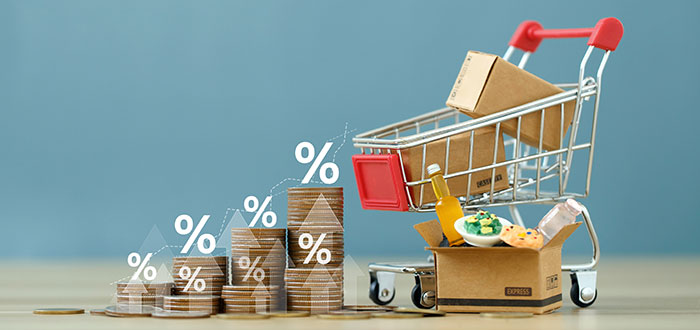
We provide our clients with monthly reports to keep them informed regarding activity on their website Through analysis of this data we then decide how and where to focus effort to continually improve the site, by implementing the correct marketing campaigns and strategies.
Here’s a snapshot of some of our food and drink clients who are taking the market by storm.
Due to the impact of COVID-19, Niche had to quickly alter their business strategy after launching in February 2020. Their original plan was to target pubs, restaurants, hotels, and event caterers as their primary market, providing a convenient alternative to having an onsite mixologist. However, when lockdowns were enforced and they found themselves with excess inventory, they established an online store and shifted their focus to roles such as picking, packing, and delivering orders.
To set up the online store, Niche enlisted the help of Virtue Design to create a website and Infotex to implement it onto the Shopify ecommerce platform. This allowed for a speedy setup process while still retaining the flexibility to utilize various apps and add-ons for added functionality. Through a Facebook advertising campaign, the site was promoted to attract new customers from across the UK. The site is also integrated with a newsletter system, allowing Niche to easily communicate with their customers via email.
Scarlett & Mustard is a British food company that produces a range of artisanal condiments and dressings. The company was founded by Sandy Ruddock and Julian Pollard in 2012, and since then gone on to gain a reputation for high-quality, locally sourced ingredients and unique flavour combinations.
Some of their most popular products include their Great Taste award-winning dressings, including the tangy and zesty Lemon & Mustard Dressing and the rich and savoury Sticky Fig & Onion Balsamic Dressing. Scarlett & Mustard also produces a range of chutneys, pickles, and sauces, all made with the same commitment to quality and taste.
With their emphasis on small-batch production and attention to detail, Scarlett & Mustard has become a favourite among foodies and gourmet enthusiasts alike.
With a range of ready-to-eat packs that are simple to use, Wayfayrer provides tasty, balanced, and nutritious meals, making them the perfect choice for camping trips. These meals have a proven track record, tracing back to the MRE rations (Meal – Ready to Eat) supplied to the British army for over 30 years.
Wayfayrer draws inspiration from the army ration range, which includes cuisines from around the world, to create their selection of delicious camping food. As the official food for the Duke of Edinburgh Award Scheme, Wayfayrer meals are of the highest quality standards and offer a range of tasty breakfasts, main meals, and desserts to help fuel your passion for adventure and prepare you for the challenges ahead.
For more examples of food and drink websites visit our work.
Need help marketing your food and drink website? Get in touch today.
Despite originating in the USA, Black Friday has been a staple of the UK shopping calendar for around 10 years. It was first introduced to the UK by Amazon in 2010, with the site regularly crashing due to high traffic levels. Asda then dared to introduce the first ‘in-store’ Black Friday sales in 2013 with offers of up to 70% off.
The idea spread quickly despite reports of broken bones in the shopping extravaganza. The annual shopping event planted deep roots on this side of the Atlantic, becoming a staple in the UK and global calendar.
To say a lot has changed since Black Friday’s introduction would be an extraordinary understatement. Even if we didn’t mention the obvious global pandemic, the cost of the living crisis and decreasing size of the UK economy, UK consumer shopping habits have changed dramatically.
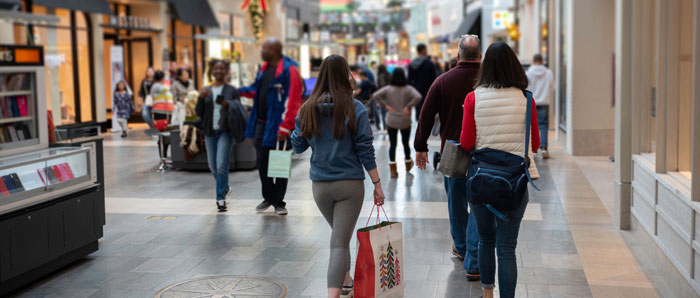
Black Friday 2022 is now over, and despite the doom and gloom of strikes and energy bills, the stats are painting a more positive picture than initially predicted. With our ecommerce and digital eye, we wanted to share a few of our observations with you.
Let’s start with the overall online stats
Long gone are the days when friends became enemies on the aisles of Currys when there appeared to be only one breadmaker (Other electric goods are available… maybe), and it had a 70% OFF red sticker. The sale has been moving ‘online’, with more customers shopping every year from the comfort of their living rooms.
Despite the end of the pandemic and a return to a more normal life, consumers continue to favour online. Footfall was up compared to 2021 but failed to surpass pre-pandemic numbers.
As the popularity of Black Friday has grown and shopping habits are moving online, businesses have had to adapt. With more significant investments into ecommerce and fulfilment, the offers have significantly decreased, making the offers more in line with other calendar sales (e.g. end of season or Boxing Day).
The average discount for orders placed in 2022 was between 12%-15%, far removed from the initial sales offers first introduced in the early 2010s. The reduced offer has meant businesses can extend the sales window, with many sales now lasting most of November.

There is no avoiding the elephant in the room in the UK, with the cost of living crisis. While the figures are not as bleak as initially feared, there is no denying that shoppers are becoming more careful with their purchasing decisions. Mainstream publications have been offering guides to the best deals available to help with shopping.
I myself had a ‘no impulse shopping’ rule. All Christmas presents were chosen in advance, online guides were read as to where the best sale would be, and Black Friday itself consisted of knowing exactly where to get the best deal for my 4-5 purchases.
Good ecommerce businesses were, however, prepared for this, with increased newsletters and email communications to ensure their customers were engaged using tools such as countdown timers and abandoned checkout notifications. On the whole, this has worked, with clickthrough rates seeing an average uplift of around 200% from emails and messages.
Every year we see more and more customers preferring to shop on their phones, and this year was no different, with 55% of all orders made on mobile. It is also expected that upto 89% of visits were from mobile devices.
An interesting, but not completely surprising, revelation was that Shopify saw an increase of 24% in sales generated by social commerce globally across their platform.
Social media platforms like Facebook and Instagram are now mature, and following investment during the pandemic has several excellent ecommerce tools. Making it easier to adopt a more transactional-based social media strategy.

While many will argue Black Friday is not as significant as in previous years because it isn’t causing a widespread shopping frenzy, I would say it is not declining but maturing. The ‘winners’ of Black Friday will no longer be those offering considerable bargains but sophisticated customer experiences that engage with and reward their audiences.
Looking at the data over the last 10 years, you will see a steady increase in mobile traffic over desktop. This is not going to stop. Look at your website through your customer’s eyes on their mobile and look for ways to improve it. More and more, we are building sites for mobile users first here at Infotex.
Make sure that you are talking to your customers. This can be as simple as offering your long-term customers exclusive deals or early access. Another quick win would be installing instant chat on your website to allow customers to easily get hold of you while on the website.
Don’t just use social media to build your brand. Use it to promote your sales in advance. By sharing previews of exclusive deals, countdown timers, and other engaging content, you can build anticipation and drive traffic to your site.
Sell directly via social media platforms with Instagram. You can put your product right in front of your target audience.
If you want to talk about improving your website for Black Friday 2023, please do not hesitate to get in touch.
Perhaps you’re finishing university and intending to take a gap year (or two) to travel the world. Maybe you’re taking your family on their first holiday abroad or simply heading off with friends for a well-earned holiday. Whatever the reason, the challenge of storing your travel documents securely, whilst ensuring you have access to everything you need in an emergency is vital. That’s where Mayday comes in.
Mayday is a web portal that can be accessed via a physical QR-coded tag, which can be worn as a bracelet, necklace, or simply as a keychain on a bag. Mayday offers vital support in a range of situations, including:
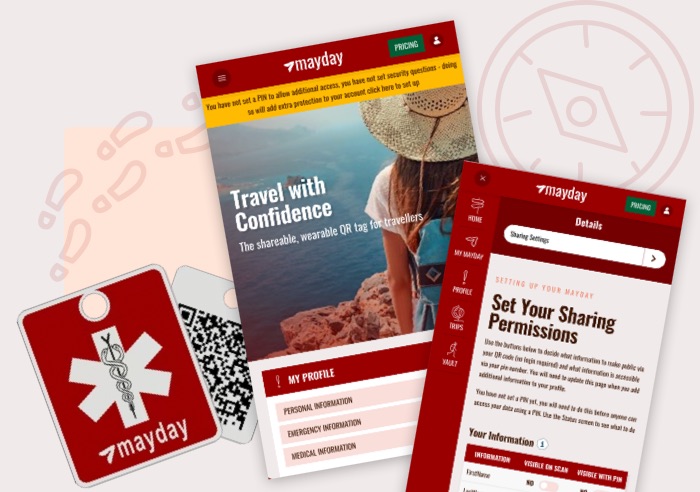
User experience and security were at the forefront of this project. With highly sensitive and personal information, we needed to be sure that everything was stored securely. Therefore we have added varying permission levels which are controlled by the account holder so that only the correct information is displayed upon scanning the QR code.
Our design team worked closely with our technical team to ensure that we developed an intuitive on-boarding process with clear signposting throughout.
“The Mayday team were a delight to work with. They ‘got’ the brief right away, hit the brand position first time, and delivered on time and on budget.”
James Dunford Wood, CEO
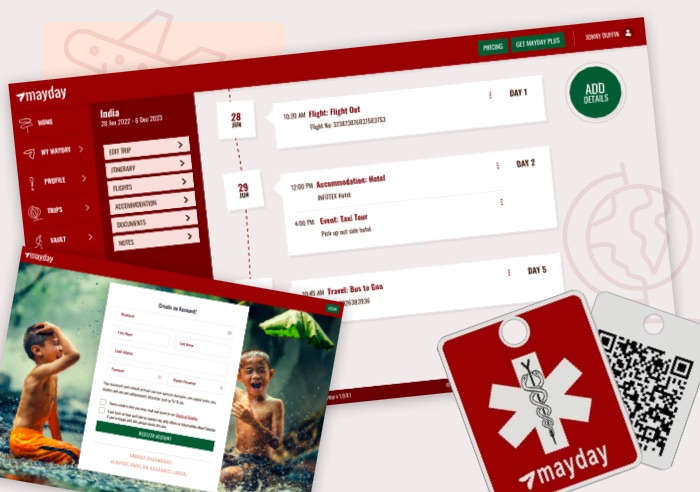
Mayday provides reassurance to both the traveler and their friends and family and we’re excited to continue to support Mayday as the platform grows.
Head over to mayday.travel to take a look and sign up for yourself.
This limited-edition article is available for a short time only… read it now before it’s too late!
Just kidding. But you get the idea…We only need to look at the speed at which loo roll stocks flew off the shelves at the start of the pandemic, or the difficulty of getting hold of lateral flow tests after the announcement of Omicron, or the hype around queuing for ticketed events (Glastonbury comes to mind, and Adele’s recent tour) to conclude that people respond quickly to news that a product is only available for a short period of time.

With everything and anything becoming available to buy online, stock “drops” – the marketing phenomena by which limited-availability products or services are released without much warning – are increasingly being employed by sellers to create new hype, energy and brand loyalties in the market.
Limited stock drops might not be the right strategy for your business, but nonetheless you can learn from the marketing tactics that fuel the phenomenon.
The rise of product “drops” is associated with the rise of “sneaker culture” in the 70’s and 80’s. With cheap, widespread mass-production, street-wear brands found a way to paint their products as rare or luxurious, creating hype and brand loyalty.
But stock drops have come a long way since the rise of e-commerce, and now the powerful business tool has fully entered the mainstream.
Marketing ploys inspired by stock drops take many forms, from limited editions to spontaneous releases. They tap into the same strategy that drives the success of price reduction sales, creating one-off items that ask the customer to make a sudden decision in the face of extreme buying pressure. The urgency and immediacy of stock drops feed into the customer’s Fear Of Missing Out (fomo) and drives decision-making buying actions. They are accompanied by a sense of community – the proximity of waiting in line for a specified product creates both customer-to-brand and customer-to-customer intimacies and engagement.
Not only does dropping stock for a limited time only create a new illusion of a product being special and one-chance-to-buy, but it can actually help a manufacturer save money on overheads, because they don’t have to make more than will be sold.

The most notable examples are the brands that brought the marketing phenomenon to the attention of the retail industry – the big street-wear names. Street-wear giants Supreme are most notable for being the first brand to make a big name for itself through limited production runs, which they continue to succeed with today, releasing a new product drop on a weekly basis. Other brands such as Nike and Adidas have followed suit by structuring their supply chains around creating buzz and excitement around the next limited-availability product, supported by apps such as Nike’s SNKRS and Adidas’ Confirmed.
Now all types of brands, from luxury fashion to fast-food restaurants and hotel-booking sites are using the marketing tool to bring in revenue. Even Amazon employs the tactic sometimes by giving Prime members a certain window of time to watch a series’ episode in advance, before the whole show airs.
For releases that create even a small amount of buzz, the internet can take it to the next level. Social media, news platforms, and online communities further expand the brand’s marketing. As you would expect, social media contributes to circulation of information around a product drop as users spread excitement about what’s coming up next, allowing micro-communities to flourish and hype to grow. Furthermore, apps such as Shopify’s Frenzy and websites like thedropdate.com keep consumers up-to-date on the latest releases from brands.

By advertising products as, for example, limited-availability! or almost out of stock! your e-commerce website needs to be fast enough to offer a super quick, convenient check out procedure with a secure payment gateway.
The long queues that are characteristic of stock dropping to a brick-and-mortar store can be created online, too. Brits are used to this, supposedly; it’s in our culture to queue for high-demand products (in fact a 2017 study showed that Brit spends 52 days of their life in a queue). So, if you’re predicting high traffic for your website, it’s essential you are prepared to deal with website queues.
Even if you don’t want to change your manufacturing plans to ride the dropping trend in a big way, you can increase the must-have appeal of what you’re selling through smaller tactics, even just in the language you use on your website.
For example, many e-commerce websites have real-time notifications that inform consumers of live updates into other buyers’ behaviours. For example, notifications might appear on the screen saying: x number of people bought this item in the last hour, or John just signed up for our newsletter, you can too…
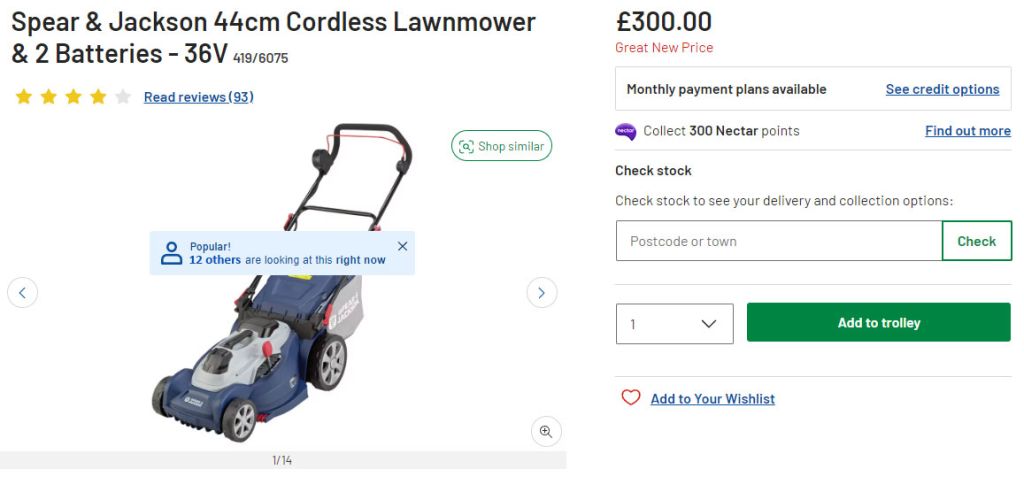
Whether or not to employ limited drop marketing tactics is highly dependent on your target audience and service. You should only target your audience with a limited drop if it will make them feel understood, and closer to your brand. Sometimes, a thoughtful, personal slowed-down shopping experience is still preferred over novelty items, so think about who you’re targeting so that your customer feels understood. The last thing you need is for your audience to feel that your brand is disingenuous or trying to create a product into a high-demand item when it is not.
Nevertheless, it is worth asking how to douse your brand in a certain must-have appeal, even if that appeal is about the experience you offer.
Choosing a platform for your ecommerce website is never easy. Finding the right combination of price, functionality, ease of development, performance and security to meet your unique set of needs can be a real balancing act – especially in a rapidly evolving market, writes Managing Director Ant Agar.
For more than 20 years, Infotex has been on a journey of discovery: we’ve seen technology change, watched a multitude of platforms come and go and, of course, we’ve built our own as well. It’s safe to say that, over the years, we’ve learned a lot.
In the early noughties, we dabbled with a handful of open-source shopping systems but ultimately found them restrictive, both technically and creatively. We much preferred bespoke development, because it enabled us to guarantee our clients that their ecommerce system would work and would do the things they specifically needed of it.
That commitment to our customers, and desire to work collaboratively to build products that directly answer a need, led to the development of our flagship products: “MozCart,” “SpaceCart,” and “FlexiStore,” as well as, over time, more than 100 more. They were a huge success for high profile customers including Micro Scooters, Adnams and Nomad Travel. And many of the products are still live today.
But the age of bespoke, like the age of steam, had to end. Budgets were squeezed and clients increasingly expected generic features and third-party integrations via plugins.
Responding to the changes, we developed ecommerce libraries on Symfony and explored Drupal commerce. We also noticed that clients were starting to request Magento sites but, although we looked into the software and supported some clients with their Magento systems, it just was not the right fit for our clients at the time. The majority of whom are small businesses with under £10million of annual sales online.
But Magento remained a name on many people’s lips. In 2017, I attended the Magento conference determined to figure it out, once and for all. And I’m glad I did. I came away with a much clearer understanding of the platform itself, the ecosystem around it, the investment it requires and the businesses it suits.
So, is Magento a good choice for your business? Here are my key takeaways:
Budget
If the maximum budget for your new website is less than £80,000, you should consider carefully whether you will be able to achieve a good implementation.
Of course, there will always be plenty of providers out there who will say they can do it for less, but this isn’t the place to skimp.
We often hear of clients who are struggling to get the Magento platform working well for them, because they’ve under-invested in the build and underestimated its complexity to manage.
Hosting
This is another core area in which we often see businesses underestimate. Magento’s complexity can be its strength, but it does mean that powerful hosting is a must.
In our experience, businesses need a budget of several hundred pounds per month for the level of hosting required. If that doesn’t sound feasible, it might be wise to consider an alternative platform. There’s absolutely nothing worse than a slow site.
Sales
Do you have thousands of products to sell, hundreds, or just a handful?
The volume of product you’re shifting is going to dictate whether or not the Magento system will be a worthwhile investment.
Ongoing Investment
Magento isn’t a system that you can leave to run itself. Its complexity means that it does demand ongoing investment in both time and budget.
From my understanding, the associated monthly running costs are in the thousands, not the hundreds; and the time and effort involved can be a challenge.
You will need to keep investing if you’re going to continue to deliver reliable performance and the expected user experience.
The table below is intended to help you think about which platform might suit you best.
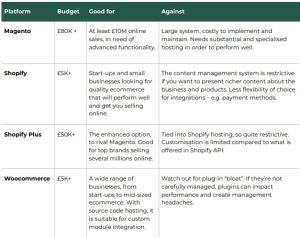
The decision to implement a product like Magento will bring cost and complexity, so it’s important to consider whether your business is the right size and shape. Our experience has been, for nearly all of our clients, that the less complex platforms can deliver all they need to grow their brands and online sales. In short, the time for Magento is when you are no longer worried about the website cost, as your business is large enough to have plenty of other things to worry about!
If you need support or guidance on what ecommerce website is right for you, we can help. Get in touch today, and we can help make a website that works for you.
With Stripe’s Payment Link system you can quickly create a page for customers to safely provide their contact details and purchase. This could be used for selling tickets to a one-off event (with a fixed value), gift vouchers, or even for recurring subscription payments. As the name suggests, you provide a specific link to your customer which relates to a certain product. They go to that page, hosted on Stripe’s secure servers, and enter their details.
Customer’s can even pay via Apple Pay or Google Pay, making it a super quick way to checkout. Not only that, Stripe’s clear pricing model of 1.4% + 20p a transaction with no monthly fees makes it very competitive.
We’ve created a demo Stripe Payment Link example here, with the majority of features enabled. Note that the system doesn’t work like a shopping basket, you can only buy the product the link has been created for, so its not a substitute for an e-commerce store.
Firstly, go to stripe.com and register for an account if you haven’t got one already. At this point you can choose to use the ‘test mode’ to see if this solution will work for you, or if you’re happy to dive in select Activate Account.
Go to the Payments section of the Dashboard, and select Payment Links in the left hand navigation.
Select New from the top right to create your first link.
You’ll need to create a new “Product” to sell. This could be for a service or subscription you offer, or for a physical product. Click into the “Find or add a product” box then “Add a Product”.

In the popup complete the name of the product and the price. You can select either a One Time price, or one that’s recurring. Within the recurring options you can set the frequency of the recurrence, from daily up to yearly. Set up the pricing carefully as once you’ve created it you will be unable to edit it.
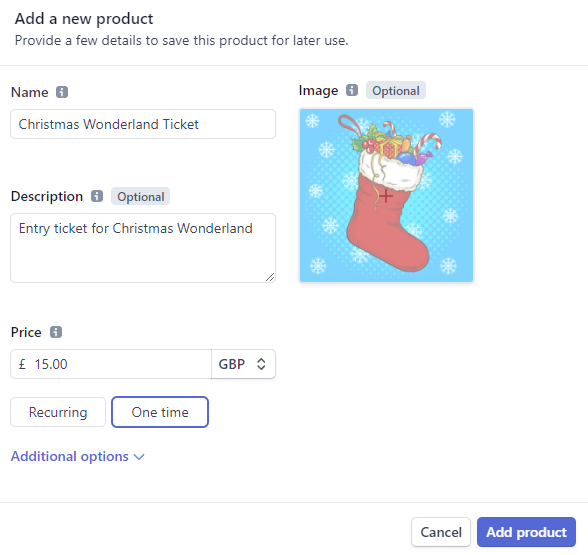
If you wish, upload an optional photo, this will show on the payment page so can be a visual clue to a customer they are purchasing the correct time. Images should be a jpg or PNG file smaller than 2mb.
Select Add Product to create the product.
Once you’ve created your product you’ll see a preview of the payment page on the right hand side.
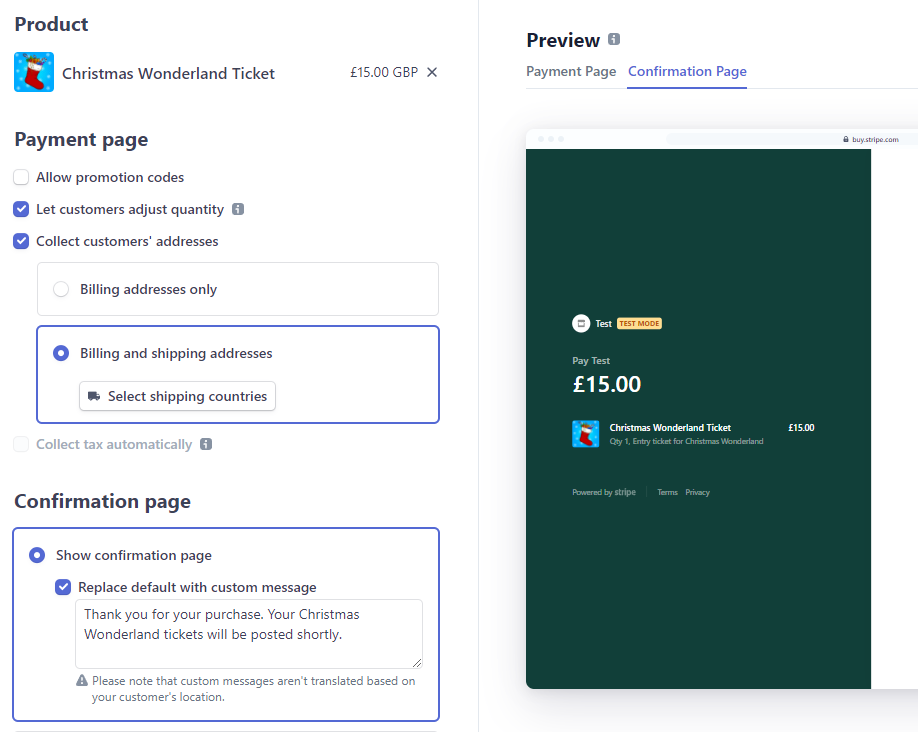
There are a variety of settings you can customise for your payment link:
Use of promotion codes – Enabling this allows customers to use discount coupons. Coupons can be created as either a percentage discount, or a fixed value amount, and can be limited to a set period of time or total number of times it can be redeemed. These are created on the main Stripe dashboard under Products : Coupons.
Adjust the quantity they can purchase – This allows a user to purchase multiple of the product you are offering.
Collect customer’s addresses – Allows a customer to provide a billing and shipping address. If you select Shipping you can select which countries you wish to ship to.
Collect tax automatically – You’ll have to do a bit more configuration to get this working, detailing your business details and item origins, but once done it’ll auto calculate tax rates.
Confirmation Page – You can either show the default Stripe confirmation page with a custom message, or redirect users to a page on your own website. You can toggle the preview of this at the top right.
Once you’re happy with you page click the Create Link button at the top right. You’ll be presented with an overview of what you’ve just set, and the all important link button at the top, so you can view your new page.
You will likely want your page styled to match your brand, although the default styling is usable out of the box. To style your page go to the Cog icon at the top right, and select Branding. In here you can assign a logo, and brand and accent colours. These will then be applied to your payment page and email receipts.
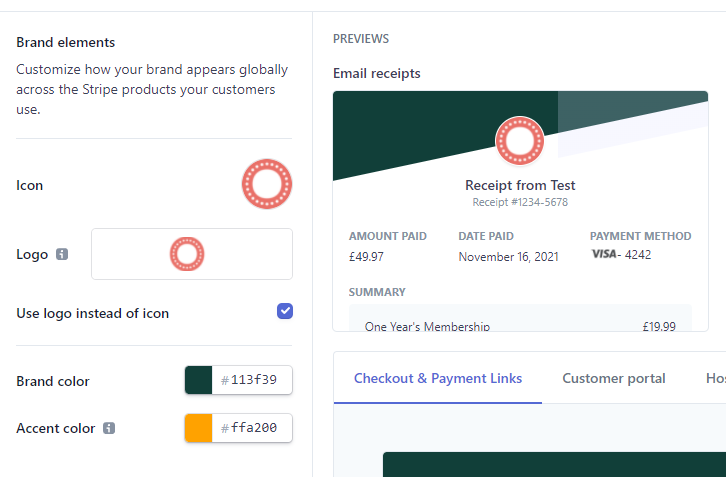
That’s it! Copy the link you created earlier and share it via email or on social media posts.
It’s great that you’ve been able to take a payment, but most companies will want to do something more with the data once an order has been place. Stripe integrates with Zapier, a hugely flexible system that links different platforms together.
A popular integration is Google Sheets, so any order placed will appear as a new row. This means you can add additional information to them, such as tracking order status or delivery tracking codes.
For further information on linking Zapier to Stripe see their help page.
Whether you offer discounts and sales or not, the huge increase in online traffic over the Black Friday weekend means there is a heightened opportunity for you to pick up those much-needed target customers. With almost a third of retail sales now occurring online in the UK, the biggest retail event of the year is not an e-commerce opportunity you want to miss…
Black Friday is a US-inspired commercial holiday that falls on the day after Thanksgiving to signify the start of the Christmas shopping period. Coined in Philadelphia in the 1950s, Black Friday made its way to our shores in 2010 when American giant Amazon offered Black Friday deals here in the UK. Cyber Monday lands on the Monday after Black Friday, 29th November. An online-only event limited strictly to 24 hours, Cyber Monday is seen as the 21st-century response to Black Friday due to the rising use of e-commerce by consumers. After the online spending boom during the 2020 lockdowns, this year’s Black Friday-Cyber Monday weekend is going to be unavoidable for online retailers looking to embrace changing consumer habits.
The sale has long been a way for retailers to drive up revenue, so you may be asking yourselves why is this anything different from the norm? Though Black Friday’s popularity initially stemmed from its (perceived) sizable savings and huge discounts, the mainstream media have since been responsible for its growing prominence in the UK retail market. It became infamous for the much-publicized hysteria and frenzies that grip a bargain-hungry public. The media circus surrounding the event was the perfect marketing tool to advertise the huge discounts on offer, triggering its exponential growth.
Mobile and tablet sales already dominate the e-commerce market and are set to increase year on year. You can optimise your site with a user-friendly cross-device design, and even consider creating a mobile app for your business, to encourage mobile users to purchase your products.
Different demographics search and shop differently online, so it is important to cover all the channels that might be reaching your target audience. This means developing great marketing campaigns for email and social media, and Pay Per Click advertising.
Customers are used to being given a range of convenient delivery options, something you must provide if you are to stay ahead of your competitors. Click and Collect services, fast and secure delivery, and ensuring a clear return policy can be game-changing for customers at checkout.
At checkout, customers on any device need to be able to quickly and securely pay for their purchases. Check out our guide to the best payment gateways to make sure you’re offering optimum payment services to keep those conversions coming.
Shoppers using search engines need to be able to find your business if you offer relevant services and products. This can’t happen unless your site is optimised for search engines, meaning your site infrastructure, content, keywords, speed, and user experience, among others, have to be thoroughly thought-through to increase your site’s rankings. Click here for more information on ranking factors for SEO.
If your site is slow you risk losing customers to an increased bounce rate and decreased SEO rankings. You can optimise your site speed by caching your web pages and making sure images are properly optimised.
In the online world, reviews are highly valued by customers as verification of your site and services, creating traffic, leads, and making conversions. Make sure you feature on multiple review platforms so that your business can maintain its reputation, exposure, and bring in trusting customers.
Just as in store, your customer experience needs to be the best that it can. As well as providing clear contact information, you might consider implementing customer service chatbots on your website in order to maintain good communication with site visitors. Alternatively, having a live chat service so visitors can directly talk to someone. Live chat is often much more convenient for a user than making a telephone call or a protracted email correspondence.
Particularly if you are putting on big sales and offers, your website traffic over the Black Friday weekend could be greater than usual. To ensure your site has the infrastructure to handle surges in traffic, speak to us today for advice.
It’s vital for you and your customers that you keep your website safe, and that you communicate your site’s security to visitors. Aside from having technically robust site infrastructure, you can also enable SSL so your customer feels secure at checkout, and display safe checkout and trust badges on your site.
For help and advice on how to optimise your website, don’t hesitate to get in touch.
Receiving prompt and secure payment for orders placed via your website is absolutely vital to any e-commerce system, but selecting and setting up the right payment gateway can often be hurried low on the agenda when setting up a new site.
The payment gateway sits as a middleman between your customer’s bank and your bank. During this process the credit or debit card is validated, checks made to ensure funds are available, anti-fraud analysis run, and then (eventually) funds are transferred to your bank.

To take payments online you will probably need an internet merchant account (IMA). Some gateways are an all-in-one solution and don’t require an IMA, such as Stripe. An Internet Merchant Account is different from your business bank account, you can’t pay in or withdraw from it – it’s just an intermediary account. The IMA enables you to start accepting online payments when used in conjunction with a payment gateway.
Internet Merchant Accounts can be obtained via your existing bank, or from some payment service providers (PSPs). The bank or the PSP will assess the risk of the business trading online, and for new companies, without a banking history, this can be a drawn-out process.
For taking payments a customer can either remain on your website to enter their card details (onsite transaction) or be taken to the gateway’s website to pay (offsite transaction). The former has an increased process for PCI compliance (see below).
Within these, there is a subset of gateways, such as Apple Pay, Google Pay and PayPal, where a user has a payment method (either a card or bank details) and contact information stored in their account with the gateway. This means a customer only needs to authenticate the transaction, such as logging in or using a or login to pay. Having these on your site can increase the conversion rate.
Sadly, as with any financial transaction, taking payments online carries a risk of fraud. All payment providers will have a level of anti-fraud technology, screening cards and customer information and grading the results. Some systems will auto-block transactions with a high risk, others will flag them so you can make a decision. There is a careful balance to find between preventing fraud and not making it difficult for real customers to pay.
3D Secure transactions, where a customer is prompted to enter a password/code to complete the transaction, are covered by a liability shift. Should a 3D Secure transaction be claimed as fraudulent, the onus moves from you to the card issuer.

Payment Card Industry Data Security Standard is a set of worldwide requirements which aim to protect cardholder information from theft and fraud. If you take any sort of credit/debit card data (including card machines) you must comply with the standards and take steps to prove you have done so to your bank. This is usually done via a Qualified Security Assessor (QSA), companies that will be helping you perform PCI compliance assessments. Failure to be PCI compliant can result in fines from your bank and the loss of the ability to take card payments.
If you use an offsite payment method then you should be able to complete a yearly Self Assessment Questionnaire (SAQ) to achieve compliance. If you take onsite payments this will involve a much more detailed questionnaire and a regular vulnerability security scan of your website and network. Using a virtual terminal (see below) will also increase your PCI requirements as you are directly handling customer’s card data.
For more information on PCI DSS please visit https://www.pcisecuritystandards.org/
Selecting a gateway shouldn’t just be about transaction fees – also check what additional services and features are available.
Virtual Terminals
A virtual terminal allows you to process card payments over the phone or via their written instructions, typing their details into your computer. You will need to see if you require a Mail Order Telephone Order (MOTO) merchant account to take advantage of a virtual terminal. Note that virtual terminals will affect the requirements of your PCI compliance.
Reporting
Reconciliation of accounts is also vital to any business, so having clear and accurate information on tap in a useful format is a huge benefit.
Invoicing & Link Payments
Some providers allow you to issue invoices directly from their platform to your customers. The invoices contain a link to pay directly online via card, so often get paid much quicker than traditional paper invoicing.
If you’re not after full invoicing, some platforms have the ability to send a simple link to a customer via email, which takes them to a payment page to enter card information.
Integrations
Maybe they offer direct integration to your accounts software or add-ons that allow for recurring payments, but check out add-ons or plugins that extend the functionality of the gateway. Also be aware of future requirements you may have, such as taking payments in other currencies and check that your chosen gateway can do those.

PayPal always comes up in discussions about online payments, being one of the most popular ways to receive online payments and very easy to set up. A common misconception is that customers need a PayPal account in order to pay, however, customers can use their credit or debit cards directly. Unfortunately, this isn’t always made clear to customers as they checkout which puts off a lot of merchants from using it as their sole gateway.
A big positive for existing PayPal customers is they have your details saved – both contact and card information. This means that the customer saves time by simply logging in to their account and accepting the transaction amount they have paid, instead of filling in forms and finding a payment card. Just having the PayPal logo on your site can encourage customers to pick your store.
PayPal has a range of ways to receive payments online, the most basic of which is PayPal buttons. These are super basic Buy Now or Pay with PayPal buttons that you can add to your site with a little bit of code. Customers can then click on them, be taken to PayPal, and then either login and pay by their existing PayPal account, or via credit or debit card.
As a step up from that is PayPal Checkout. This integrates with your ecommerce store so customers can have a basket full of items to checkout with, again being taken to PayPal to complete their purchase.
PayPal has also recently added PayPal Credit, where customers can buy now and pay later, with 0% interest on orders over £99. Customers are pre-approved, and obviously terms and conditions apply. This is all handled on PayPal’s side, so from a merchant point of view doesn’t require you to do anything.
PayPal isn’t always the most popular with merchants though, with higher than average transaction fees if you’re a low volume merchant, and there have been reports of accounts being suspended with little to no notice.

Previously known as Sage Pay, Opayo is a very popular payment gateway. This is more of a traditional gateway, where the customer is asked to enter their payment details – so no quick checkout with saved cards as with PayPal.
Opayo has a range of site integration methods, both on and off-site, and can accept deferred and recurring payments. They have a few pricing plans, with the most basic starting at £25p/m for 350 transactions.

Stripe may not be a name familiar to everyone, but it’s used on thousands of sites, including deliveroo, Waitrose, and booking.com. They have competitive transaction fees with no setup or monthly costs. It is easily integrated into WooCommerce and allows you to take Apple Pay and Google Pay as well. The admin area is a little busy and takes a while to learn.

Another of the big names in online payments, Worldpay offer an onsite or offsite payment gateway integration. Prices start at £19 per month, and minimum contract applies. Outside of that their fee structure is opaque and requires you to contact them. They also offer physical card terminals, for those of you doing face to face payments.

Like PayPal, Google Pay and Apple Pay are hugely powerful logos to have on your site. People know they will be able to checkout quickly, as their payment and delivery details are already saved on their device. Usually, you would have other payment options alongside Google Pay and Apple Pay, for people to purchase with a debit or credit card. Integration is also usually done via another payment gateway, for example if you use Stripe and WooCommerce you can enable them without having to register for separate accounts.
Not strictly a payment gateway, GoCardless allows you to take recurring payments directly from your customer’s bank accounts. GoCardless are effectively a modern take on Direct Debits, which is the basis of their system is built upon.

Klarna allows customers to split their payments across multiple interest-free instalments. Klarna pays the merchant for the product as soon as the customer completes their purchase. Again, it’s another option that isn’t clear on their transaction fees, but it’s somewhere around 2.49%+20p per transaction. This option can be popular with customers, but there are grumblings about being refused payment options and charges being taken when goods had been returned.
WooCommerce Payments is built on the backbone of Stripe, with identical fee structure, it provides an integrated interface directly into your WooCommerce store admin area for managing payments. Customers can pay directly in your website without leaving to go to a separate gateway site, and save their card details for faster payments in the future.
It’s always best to speak to your web development agency before engaging with any payment gateway, as they will have experience with a wide range of them and can help you navigate the pitfalls. They will also be familiar with what gateways your ecommerce site can work with, as some platforms are harder to integrate than others and while you may save a few pounds on your transaction fees the initial integration fees can offset that.
You probably like reading reviews before you purchase a product or service, right? They’re our most trusted source of, well, whether to trust something. Reviews are an essential marketing tool – drawing traffic, creating leads, and making conversions.
People sometimes put off signing up to review sites for fear of receiving negative online reviews, or even none at all. However, you need business reputation to drive traffic, and there are ways to cope with negative online reviews should they arise. Indeed, even negative customer reviews are important because they can help you to see where you might need to improve your customer service.
Maybe you want to be on all the review sites to get the most exposure as possible, or maybe you want to start with just one. Either way, we’ve put together some of the most popular review platforms out there. These cover the biggest B2C and B2B review sites, but of course there are many more out there for particular service and target consumer niches.
Whether you’re business can be found on lots of reviewing platforms or not, don’t forget to include some of those all important testimonials you receive on your own website. If you don’t wish to use a 3rd party like Feefo or Trustpilot then many website platforms such as WordPress or Shopify have their own on-site review systems you can use to get valuable customer feedback automatically.
Business reviews and ratings are now often included in search results. Google, for instance, will often directly display online business reviews and consumer ratings following a search, as shown below.

With internet sales accounting for over a third of all retail sales in the UK, we thought we would dig deeper into the trends keeping ecommerce businesses ahead of the game. And first, it is video.
You may know already that the younger generation are the video generation… and they’re only going to continue growing. TikTok, Amazon Live, InstagramTV… it’s hard to ignore that video is the desired content. In fact, data from The State of Video Marketing Survey 2021 suggests that the average person watches 18hrs of video content every week (2.5hrs per day).
No wonder YouTube remains the second largest search engine in the world. Since its first video upload (“Me At The Zoo”) in 2006, it has grown and grown. Easy to upload to, and easy to embed into your site, it can also help you gain additional exposure in search engine result pages. And it’s free.
Video is the best virtual option for bringing people closer to a real-life retail experience. ASOS were one of the first to allow users to get a view of how their clothes look on a real person while they walk up and down – not exciting, but video that is certainly well appreciated by their customers.
Now some stores even have virtual fitting rooms – like Visualook – so that you can make sure you get the perfect size. In our current pandemic situation more than ever, people are looking to live out physical experiences recreated as closely as possible online.
You’ve probably heard by now that, as a result of technology, most people online have a shorter attention span than a goldfish (8 seconds compared to their superior 9). This means that there is a small window to catch someone’s attention on your website homepage or in their social media thread. Videos are proving the most effective way to do that.
In case we need confirmation of the attention-grabbing quality of video… it says it all that people are twice as likely to share video content with their contacts than other types of content such as text, images or audio. This has big benefits for social media expansion.
Video is rankable on search engines, and so it can help increase traffic to your website in the same way as text and keywords can. Videos will not only increase your organic traffic in this way, but are easily shared on social media, which in turn leads users to look up your product in search engines for more information.
Having videos on your ecommerce website builds trust between you and your customer. Clients can more clearly and accurately see the product depicted, and are therefore more likely to believe that they will get what they pay for. What’s more, the investment you make in the creation of the video informs your client of how strongly you believe in the value of your product.
When customers feel properly informed about a product, they are more likely to convert to sale. Similarly, knowing what to expect in a product means that customers are less likely to return an item if they’ve seen it on a video.
The most commonly-created type of video for ecommerce are explainer videos. Quite simply, they explain your product or service. Often animations, such videos provide the means to concisely and effectively communicate what your business proposition has to offer. Dropbox notoriously found its market through its explainer videos released by founder Drew Houston to communicate his concept.
One of our clients, Access Garden Products, uprooted some of their archive video guides from the 1990s and recreated them for their current products. Take a look on their website: www.garden-products.co.uk.
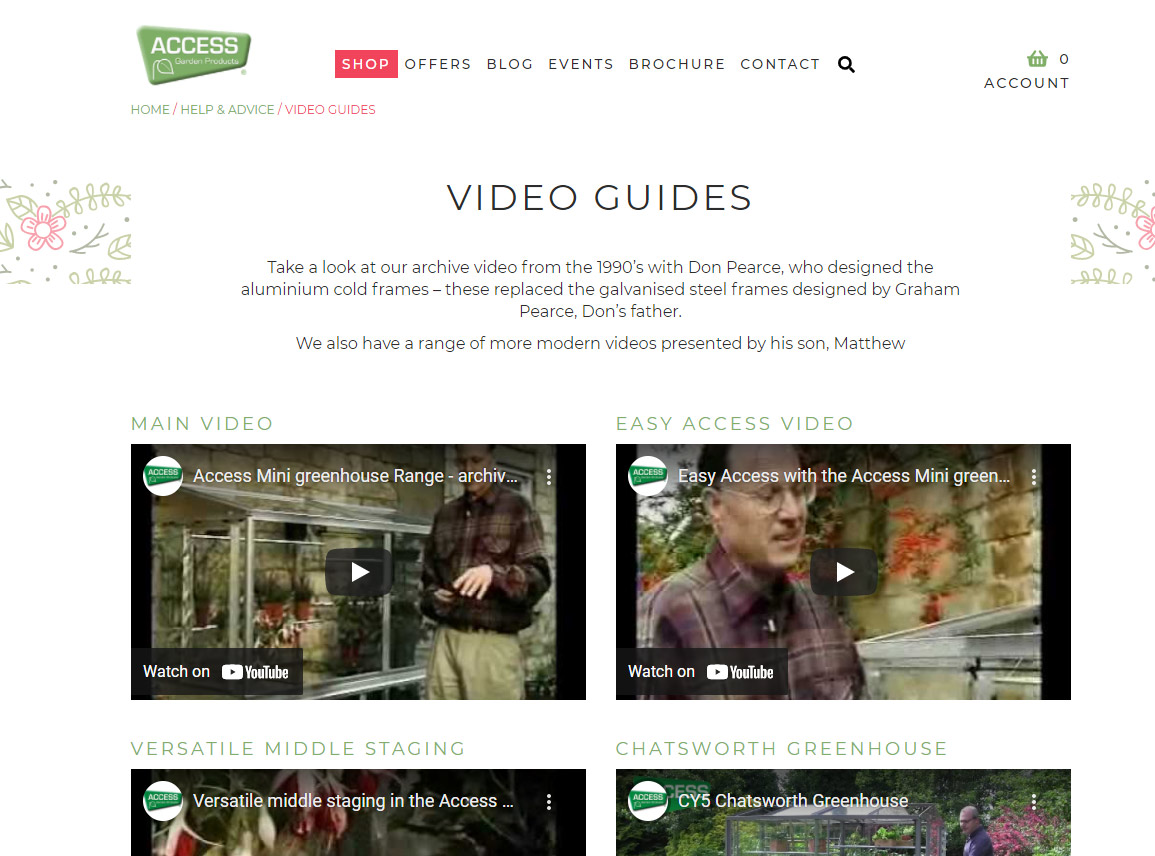
The closer a product looks online to how it really is when a customer receives it, the less likely it is to be returned. Product demos help a client to know what to expect from a product, and this increased trust means increased conversions.
Take away that element of dissatisfaction that flashes across a customer’s face when the parcel just isn’t quite what they expected… Are mugs usually so small?
By offering a step-by-step guide to how to use your product, your clients will know what to expect and thus feel more secure in their purchase decision making.
Everyone is drawn to narratives, so having a short story video on your site can be an effective way to get clients interested in your brand or product in a personal way.
Online shopping can be overwhelming, even just in terms of choosing from the sheer range of products on offer. A comparison video can help a client decipher between two similar products on the market, and clearly outline the pros and cons of each to take away some of that purchasing reluctance, and help them make an informed choice.
User-generated videos are on the rise, and, in the same way as written reviews, can do wonders in building a potential client’s trust in your product or service.
Discover how our team can help you on your journey.
Talk to us today